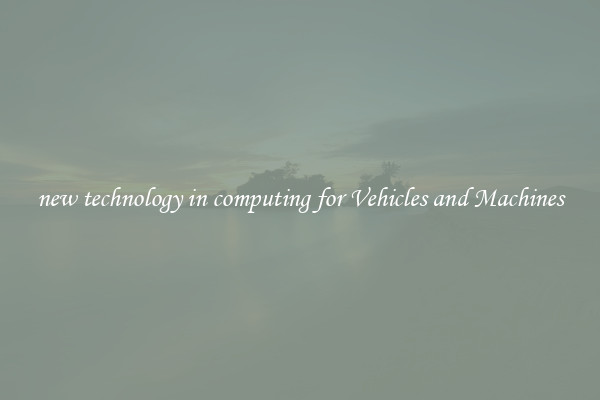new technology in computing for Vehicles and Machines
Title: Advancements in Computing Technology for Vehicles and Machines

Introduction
The rapid advancements in technology have revolutionized every sector, and the automotive and machinery industry is no exception. Computing technology has played a vital role in enhancing the efficiency, safety, and overall performance of vehicles and machines. In this article, we will explore some of the latest computing technologies that are transforming the way vehicles and machines operate.
1. Artificial Intelligence (AI)
Artificial Intelligence has emerged as a game-changer in the realm of vehicle and machine computing. AI-enabled systems can analyze vast amounts of data in real-time and make quick decisions based on that analysis. In the automotive industry, AI is employed in autonomous vehicles to navigate, identify objects, and predict and respond to various scenarios on the road. In the machinery sector, AI is utilized to optimize manufacturing processes, monitor equipment health, and facilitate predictive maintenance, resulting in reduced downtime and increased productivity.
2. Machine Learning (ML)
Machine Learning, a subset of AI, allows vehicles and machines to learn from past experiences and improve their performance without explicit programming. ML algorithms can analyze data collected from sensors and devices to identify patterns, make predictions, and detect anomalies. In the automotive domain, ML algorithms help vehicles adapt to diverse driving conditions by continuously learning and improving their decision-making capabilities. In the machinery industry, ML enables real-time monitoring of equipment performance and helps predict failures, allowing for preventive measures and avoiding costly downtime.
3. Internet of Things (IoT)
IoT has opened up a world of possibilities in the vehicle and machine computing domain. Through a network of interconnected devices and sensors, IoT enables seamless communication and data exchange between vehicles, machines, and their operators. IoT devices embedded in vehicles gather real-time data on engine performance, fuel consumption, and driver behavior, improving fuel efficiency, safety, and maintenance planning. In the machinery sector, IoT facilitates remote monitoring, provides real-time alerts on equipment failures, and optimizes resource allocation, resulting in higher operational efficiency and cost savings.
4. Edge Computing
Edge computing brings computational power closer to the source of data generation, enabling real-time analysis and decision-making at the edge of the network. In the automotive sector, edge computing allows vehicles to process data locally, reducing latency and enhancing safety-critical applications such as collision avoidance systems. In the machinery industry, edge computing enables faster data analysis for real-time control, improves equipment efficiency, and supports remote diagnostics and maintenance.
Conclusion
The integration of advanced computing technologies such as AI, ML, IoT, and edge computing has revolutionized the automotive and machinery industry. These technologies have brought about improvements in safety, efficiency, and productivity. As technology continues to advance, we can expect vehicles and machines to become even smarter, more autonomous, and interconnected, leading to a future of increased automation and intelligent decision-making in transportation and manufacturing.

View details

View details

View details

View details








